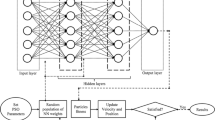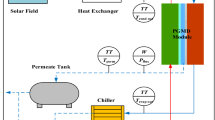Abstract
Nonlinear identification of a distillation column is a challenging problem in the process industry. The performance of the controller of nonlinear and dynamic columns can be viewed or analyzed using this type of identification. In this work, a novel method is proposed for the identification of a distillation column using hybrid PSO (particle swarm optimization) and ANN (artificial neural network). Since the real distillation column is dynamic in nature, this hybrid system is used as a nonlinear function in NARX (nonlinear autoregressive with exogenous input) structure. This hybrid NARX model is called PSO-NARX-ANN. In PSO-NARX-ANN, NARX-ANN is trained by using the PSO algorithm. The PSO training process has the advantage of training neural network without getting trapped at local optimal points. Reflux rate and reboiler temperature were used as variable inputs while the top and the bottom compositions (mole fractions) were used as variable outputs. The column was realistically simulated in HYSYS process simulation software and data was generated. To ensure robustness and accuracy, 750 of the 1000 samples of data collected from HYSYS were used for training, and the remaining 250 samples of data were used for validation of the proposed model. The performance of proposed model compared with (back propagation) BP-ANN, NARX-BP-ANN, and PSO-ANN. The results showed that PSO-NARX-ANN outperformed all others.






















Similar content being viewed by others
References
Araromi DO, Sonibare JA, Emuoyibofarhe JO (2014) Fuzzy identification of reactive distillation for acetic acid recovery from waste water. J Environ Chem Eng 2:1394–1403. https://doi.org/10.1016/j.jece.2014.05.008
Bachnas AA, Tth R, Ludlage JHA, Mesbah A (2014) A review on data-driven linear parameter-varying modeling approaches: a high-purity distillation column case study. J Process Control 24:272–285. https://doi.org/10.1016/j.jprocont.2014.01.015
Blum C, Socha K (2005) Training feed-forward neural networks with ant colony optimization: an application to pattern classification. His 05:6. https://doi.org/10.1109/ICHIS.2005.104
de Canete JF, Cordero T, Guijas D et al (2000) An adaptive neuro-fuzzy approach to control a distillation column. Neural Comput Appl 9:211–217. https://doi.org/10.1007/s005210070014
Dutta P, Rhinehart RR (1999) Application of neural network control to distillation and an experimental comparison with other advanced controllers. ISA Trans 38:251–278. https://doi.org/10.1016/S0019-0578(99)00025-7
Eberhart R, Kennedy J (1995) A new optimizer using particle swarm theory. In: Proc Sixth Int Symp Micro Mach Hum Sci, pp 3943.https://doi.org/10.1109/MHS.1995.494215
Escamilla-Salazar IG, Torres-Trevi No L, Gonzalez-Ortiz B (2016) Intelligent parameter identification of machining Ti64 alloy. Int J Adv Manuf Technol. https://doi.org/10.1007/s00170-015-7967-4
De Canete JF, Del Saz-Orozco P, Garcia-Moral I, Gonzalez-Perez S (2012) Indirect adaptive structure for multivariable neural identification and control of a pilot distillation plant. Appl Soft Comput J 12:2728–2739. https://doi.org/10.1016/j.asoc.2012.03.062
De Canete JF, Garcia-Cerezo A, Garcia-Moral I et al (2013) Object-oriented approach applied to ANFIS modeling and control of a distillation column. Expert Syst Appl 40:5648–5660. https://doi.org/10.1016/j.eswa.2013.04.012
Jaleel E, Aparna K (2015a) Identification of benzene-toluene sistillation column using neuro-fuzzy algorithm. IEEE INDICON https://doi.org/10.1109/INDICON.2015.7469599
Jaleel E, Aparna K (2015b) Identification of Ethane-Ethylene Distillation Column Using Neural Network and ANFIS. In: 2015 Fifth Int Conf Adv Comput Commun, pp 358361.https://doi.org/10.1109/ICACC.2015.17
Jaleel E, Aparna K (2016) Neuro-fuzzy soft sensor estimator for benzene toluene distillation column. Procedia Technol 25:9299. https://doi.org/10.1016/j.protcy.2016.08.085
Jones AJ (1993) Genetic algorithms and their applications to the design of neural networks. Neural Comput Appl 1:32–45. https://doi.org/10.1007/BF01411373
Kalinli A, Sagiroglu S, Sarikoc F (2010) Parallel ant colony optimization algorithm based neural method for determining resonant frequencies of various microstrip antennas. Electromagnetics 30:463–481. https://doi.org/10.1080/02726343.2010.483939
Karaboga D, Akay B, Ozturk C (2007) Artificial bee colony (ABC) optimization algorithm for training feed-forward neural networks. Model Decis Artif Intell 4617:318–329. https://doi.org/10.1007/978-3-540-73729-2_30
Li X, Lu WF, Zhai L et al (2015) Remaining life prediction of cores based on data-driven and physical modeling methods. In: Nee AYC (ed) Handbook of manufacturing engineering and technology. Springer, London, pp 3239–3264
Ljung L (1987) System identification theory for the user. Prentice Hall, Englewood Cliffs
Lu J, Hu H, Bai Y (2015) Generalized radial basis function neural network based on an improved dynamic particle swarm optimization and AdaBoost algorithm. Neurocomputing 152:305–315. https://doi.org/10.1016/j.neucom.2014.10.065
Luo RF, Shao HH, Zhang ZJ (1995) Fuzzy-neural-net-based inferential control for a high-purity distillation column. Control Eng Pract 3:31–40. https://doi.org/10.1016/0967-0661(94)00061-K
Luyben WL (2002) Plantwide dynamic simulators in chemical pocessing and control. CRC Press, New York
Macmurray JC, Himmelblau DM (1995) Modeling and control of a packed distillation column using artificial neural networks. Comput Chem Eng 19:1077–1088. https://doi.org/10.1016/0098-1354(94)00098-9
Mahindrakar V, Hahn J (2014) Dynamics and control of benzene hydrogenation via reactive distillation. J Process Control 24:113–124. https://doi.org/10.1016/j.jprocont.2014.01.005
Mavrovouniotis M, Yang S (2015) Training neural networks with ant colony optimization algorithms for pattern classification. Soft Comput 19:1511–1522. https://doi.org/10.1007/s00500-014-1334-5
Meissner M, Schmuker M, Schneider G (2006) Optimized particle swarm optimization (OPSO) and its application to artificial neural network training. BMC Bioinf 7:125. https://doi.org/10.1186/1471-2105-7-125
Miccio M, Cosenza B (2014) Control of a distillation column by type-2 and type-1 fuzzy logic PID controllers. J Process Control 24:475–484. https://doi.org/10.1016/j.jprocont.2013.12.007
Mohamed Ramli N, Hussain MA, Mohamed Jan B, Abdullah B (2014) Composition prediction of a Debutanizer column using equation based artificial neural network model. Neurocomputing 131:59–76. https://doi.org/10.1016/j.neucom.2013.10.039
Nasimi R, Irani R (2014) Identification and modeling of a yeast fermentation bioreactor using hybrid particle swarm optimization-artificial neural networks. Energy Sourc Part A Recover Util Environ Eff 36:1604–1611. https://doi.org/10.1080/15567036.2011.592903
Ochoa-Estopier LM, Jobson M, Smith R (2012) Operational optimization of crude oil distillation systems using artificial neural networks. Comput Aided Chem Eng 30:982–986. https://doi.org/10.1016/B978-0-444-59520-1.50055-5
Osuolale F, Zhang J (2015) Distillation control structure selection for energy-efficient operations. Chem Eng Technol 38:907–916. https://doi.org/10.1002/ceat.201400707
Pan Y, Er MJ, Li X et al (2014) Machine health condition prediction via online dynamic fuzzy neural networks. Eng Appl Artif Intell 35:105–113. https://doi.org/10.1016/j.engappai.2014.05.015
Pan Y, Hu X, Er MJ et al (2013) Bearing condition prediction using enhanced online learning fuzzy neural networks. In: Nee AYC, Song B, Ong SK (eds) Re-engineering manufacturing for sustainability. Springer, Singapore, pp 175–182
Pratama M, Er MJ, Li X et al (2013) Data driven modeling based on dynamic parsimonious fuzzy neural network. Neurocomputing 110:18–28. https://doi.org/10.1016/j.neucom.2012.11.013
Ramchandran S, Russell Rhinehart R (1995) A very simple structure for neural network control of distillation. J Process Control 5:115–128. https://doi.org/10.1016/0959-1524(95)90348-I
Rani A, Singh V, Gupta JRP (2013) Development of soft sensor for neural network based control of distillation column. ISA Trans 52:438–449. https://doi.org/10.1016/j.isatra.2012.12.009
Rasoulifard MH, Seyed Dorraji MS, Amani-Ghadim AR, Keshavarz-Babaeinezhad N (2016) Visible-light photocatalytic activity of chitosan/polyaniline/CdS nanocomposite: kinetic studies and artificial neural network modeling. Appl Catal A Gen 514:60–70. https://doi.org/10.1016/j.apcata.2016.01.002
Ravi Sriniwas G, Arkun Y, Chien I-L, Ogunnaike B (1995) Nonlinear identification and control of a high-purity distillation column: a case study. J Process Control 5:149–162. https://doi.org/10.1016/0959-1524(95)97302-9
Torrecilla JS, Aragn JM, Palancar MC (2008) Optimization of an artificial neural network by selecting the training function. Application to olive oil mills waste. Ind Eng Chem Res 47:7072–7080. https://doi.org/10.1021/ie8001205
Tsai JT, Chou JH, Liu TK (2006) Tuning the structure and parameters of a neural network by using hybrid Taguchi-genetic algorithm. IEEE Trans Neural Netw 17:69–80. https://doi.org/10.1109/TNN.2005.860885
van den Bergh F, Engelbrecht AP (2000) Cooperative learning in neural networks using particle swarm optimizers. S Afr Comput J 26:84–90
Whitley D, Starkweather T, Bogart C (1990) Genetic algorithms and neural networks: optimizing connections and connectivity. Parallel Comput 14:347–361. https://doi.org/10.1016/0167-8191(90)90086-O
Zhang C, Shao H, Li Y (2000) Particle swarm optimisation for evolving artificial neural network. In: Syst Man, Cybern 2000 IEEE Int Conf, vol 4, pp 2487-2490 https://doi.org/10.1109/ICSMC.2000.884366
Author information
Authors and Affiliations
Corresponding author
Appendices
Appendix
A Dynamic mathematical model
Distillation column trays are numbered from top to bottom. In the following equation, \(L_{R}\), D, V, L, M, B, \(x_{i}\), and \(y_{i}\) are used for reflux flow, distillate flow, vapor flow, liquid flow, hold up, the liquid mole fraction of the component, and vapor mole fraction of component respectively. Mass balance and component mass balance at different stages are given below.
At the condenser,
At the all stages except condenser, feed stage and reboiler is given by
At the feed stage,
At the reboiler,
Vapor and liquid flow in all stages except feed stage is represented by
Vapor and liquid flow in the feed stage is given by
where q is given by equation
Vapour liquid equilibrium relationship of component is given by Eq. 30
Rights and permissions
About this article
Cite this article
Abdul Jaleel, E., Aparna, K. Identification of realistic distillation column using hybrid particle swarm optimization and NARX based artificial neural network. Evolving Systems 10, 149–166 (2019). https://doi.org/10.1007/s12530-018-9220-5
Received:
Accepted:
Published:
Issue Date:
DOI: https://doi.org/10.1007/s12530-018-9220-5




